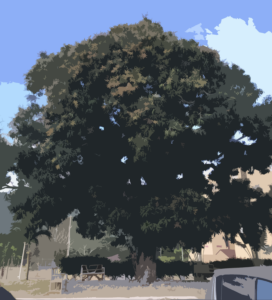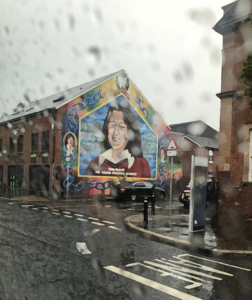Decolonizing and Opening the Academy via Study Abroad

kīyohkēwin is the Cree word for visiting. It is always good when we can make the time to visit, find our laughter, share our stories, and remember. Often there is food, learning, and inspiring conversations. So I’ve named our podcast to honour this.
Began

In 2018, I had the opportunity to take a study abroad class going to Ireland with Michael and a group of graduate students from the University of Saskatchewan. I can remember standing at by a fence looking out over the ocean near the Giant’s Causeway, visiting with Michael and responding to his questions as I rambled off ideas about study abroad and using the tools of distance education. That conversation has taken us on a really good journey. It’s where we began.
Press play and listen to our podcast. (34:14 minutes)(pdf transcript)
Questions: After listening to the podcast, what more do you need to explore or learn about based on our visit? What questions do you have and where can you find answers?
Reading
Miliante, J. (2020). Kindred Spirits: Solidarity Between the Choctaw Nation of Oklahoma and Ireland. IJAS Online, 9, 45–48. https://www.jstor.org/stable/27032401
Design
Press play to listen as I share a brief overview of some of the design work Michael and I have done together. (5:47 minutes)(pdf transcript)

The WordPress site was created for students to share their reflections of their learning with the whole class.
Questions: Why is it important to share stories about the work we have done to design learning? Who benefits?
Gather

The challenge in moving from study abroad to virtual study abroad is in finding those obvious places to gather online. In the literature and blogs we see connections to topics like building online communities in higher education. It is essential because too often relationality is lost or dismissed online. In 2020, just before the pandemic we went to Jamaica for a study abroad class. We stayed at the University of the West Indies campus and just outside our accommodations was this beautiful mango tree that became a our central gathering place. We also spent a lot of time together on the bus as we travelled throughout the island. In those moments of being together you learn about people and you swiftly lean towards ones you to hope to establish bonds with.
Questions: How do we intentionally design for community a virtual study abroad class? Where can students gather online to establish their own mango tree or virtual bus so they can build those good relationships and learn to support each other beyond the class?
Readings
DiRose, J. (2021, August 31). What is Online Community? Discourse blog. https://blog.discourse.org/2021/08/online-community/
O’Malley, S. (2017, July 26). Professors Share Ideas for Building Community in Online Courses. Inside Higher Ed. https://www.insidehighered.com/digital-learning/article/2017/07/26/ideas-building-online-community
Pedersen, A. (2021, August 27). What is Virtual Study Abroad and Why You Should Consider It. GoOverseas. https://www.gooverseas.com/blog/virtual-study-abroad
Wehler, M. (2018, July11). Five Ways to Build Community in Online Classrooms. Faculty Focus. https://www.facultyfocus.com/articles/online-education/online-student-engagement/five-ways-to-build-community-in-online-classrooms/
Shift

When we hear of the hidden curriculum we can tend to connect it to those negative messages and inequities that too often exist higher education. But what if we could shift that perspective and decolonized it. What if, instead of focusing on perceived gaps and missing privilege and all of the connected implications, we considered the hidden curriculum in terms of the beneficial learning and interactions that we see take place outside of the lectures and formal learning during study abroad. In Cree, the word for this is kīmōc (pronounced kē’mooch); it is when you are doing something on the side or on the sly. In study abroad we can see this hidden curriculum emerge on the kīmōc and it is inspiring to be a part of. It is where building good relationships are prioritized, reconciliation grows, and decolonization thrives on the kīmōc. It is centred in the discourse of internationalization, when students and their professor leave their country and established norms of their places in society. Those higher education priorities that exist in the policies, as flat words on our university websites, come to life in study abroad when we bring together Indigenous and non-Indigenous students and they are able to find those opportunities and experience the disorienting dilemmas of Meziro’s transformative learning theory.
At its most radical, decolonization means “resisting and actively unlearning the dangerous and harmful legacy of colonization, particularly the racist ideas that Black, Indigenous, and People of Color (BIPOC) people are inferior to White Europeans.” It entails interrogating and dismantling “power structures that carry legacies of racism, imperialism, and colonialism.” But more commonly, it calls on faculty to address a series of curricular, pedagogical and evaluative challenges.” (Mintz, 2021, June 22)
Question: How do we design with intentional space for students to incorporate those transformative learning experiences that can happen outside of the formal learning that takes place in study abroad?
Readings
What is transformative learning theory? (2020, July 17). Teaching and Education. https://www.wgu.edu/blog/what-transformative-learning-theory2007.html#close
Mintz, S. (2021, June 22). Decolonizing the Academy. Inside HigherEd. https://www.insidehighered.com/blogs/higher-ed-gamma/decolonizing-academy
Next

Truly the best part of my position as an instructional designer in higher education is working with faculty who come back with more ideas for what we need to work on next. As Michael and I were visiting, there was a point where I mentioned an idea that I told him I would cut out. But as you listen, you can hear our spirit of collaboration for our next potential project take hold. Who knows if we will actually work on this, but it made for a great conversation.
Press play and listen as we discuss what’s next. (2:04 minutes)(pdf transcript)
Questions: As you consider your own design practice, in what ways could you build onto existing projects or extend them in new directions? Think about the relationships you will build in your own design practice as you work with faculty. Why are those good relationships essential?
ēkosi
That first conversation, looking out over the ocean together, has taken us quite far and I have been really fortunate to have been a part of this journey. ēkosi.
Kristine
Attribution
Images and writing by of Kristine Dreaver-Charles, licensed under CC BY-NC 3.0.
Podcast audio recordings by Kristine Dreaver-Charles and Michael Cottrell, licensed under CC BY-NC-ND 4.0.
tēniki
Thanks to Professor Randy Morin of the University of Saskatchewan, and his Cree language help.
Thanks to Devin Kyle of the University of Saskatchewan, and his help editing our audio podcast files and producing transcripts.